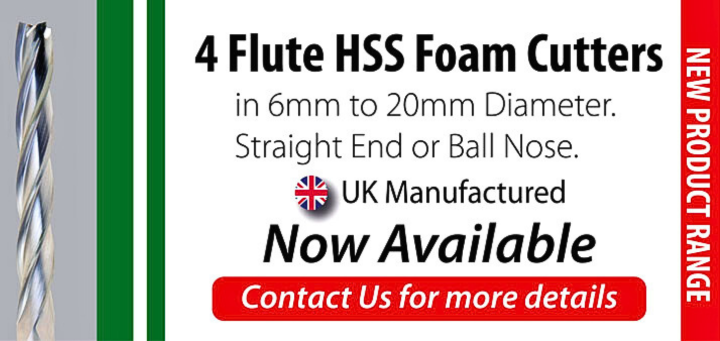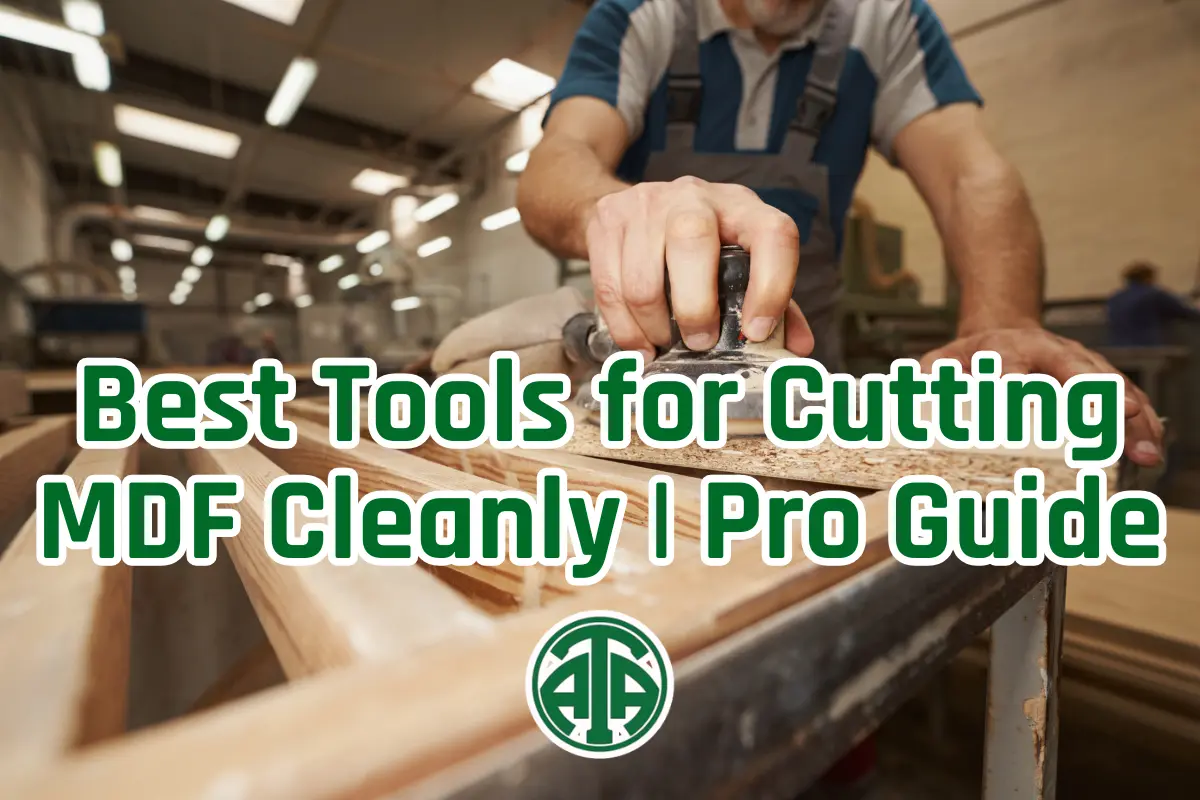Medium Density Fibreboard, or MDF, is a staple material across furniture making, interior fit-outs, and joinery. It’s affordable, stable, and finishes beautifully. When it comes to cutting, MDF, there are a few things to keep in mind:
Its dense composition makes it tough on blades, while the fine, powdery dust it produces is not only messy, but potentially hazardous without the right PPE. MDF is also prone to chipping or splintering, particularly along the cut edges, which can compromise finish quality and joint alignment.
That’s why choosing the right cutting tool—and using it correctly—is essential. Whether you’re a workshop professional, CNC operator, or a contractor working on-site, this guide will walk you through the best tools for clean, safe, and accurate cuts in MDF, while also offering practical tips based on ATA Engineering’s decades of tooling experience and our extensive range of solid carbide cutters for MDF.
MDF Tool Recommendations based on Cut Type & Precision
1. Table Saw with Carbide-Tipped Blade
Best for: Long, straight cuts and large sheet processing.
For consistent accuracy and a crisp edge, the table saw remains a workshop favourite—especially when fitted with a 60–80 tooth solid carbide-tipped blade. The solid, flat surface offers excellent control over sheet material, making it easier to keep the blade square and avoid any unintended angle that could throw off your final dimensions.
Why it’s ideal:
- Delivers clean, straight cuts with repeatable accuracy.
- Minimises chipping, especially when paired with a backer board or scoring technique.
- Suitable for high-volume or production environments.
Tips for best results:
- Adjust blade height just above the MDF surface to reduce tear-out.
- Always use a rip fence or guide rail for alignment.
- Back up the cut line with scrap material to avoid underside chipping.
For crisp top edges, the Onsrud 57-400 Downcut Router Bit is ideal. If you need clean top and bottom edges for laminated or double-sided panels, the 60-600 Compression Spiral Bit provides exceptional finish quality.
2. Circular Saw with Carbide-Tipped Blade
Best for: On-site work, smaller panels, and mobile setups.
When workshop space is limited or materials need to be cut on-site, a circular saw fitted with a fine-tooth carbide blade can provide great results—if used correctly. Accuracy starts with setup: use a straight edge or guide rail to avoid blade drift and ensure square cuts.
Why it’s ideal:
- Portable and adaptable to various job sites.
- Can match table saw accuracy when paired with proper guidance tools.
- Effective on full sheets or partial cuts.
Tips for best results:
- Set the blade depth just slightly deeper than the MDF thickness.
- Clamp a straight edge guide for perfectly straight lines.
- Feed the saw slowly and steadily to avoid splintering.
If you’re routing edges or plunge-cutting MDF sheets, the Onsrud 57-900 Downcut Bit minimizes top-face chipping, while the 63-200 Upcut Spiral Bit provides clean, chip-free removal when depth and evacuation matter.
3. Jigsaw (for Curves and Intricate Cuts)
Best for: Curved shapes, cutouts, or decorative features.
For curved work or internal cutouts—think sink cut-ins, cabinet corners, or rounded edges—a jigsaw is the go-to tool. That said, it’s not the cleanest option. MDF’s structure means the jigsaw is prone to splintering, especially along the top surface, unless a fine-tooth blade is used and cutting is done slowly.
Why it’s ideal:
- Handles non-linear cuts that circular saws or table saws can’t.
- More flexible for custom shapes.
- Great for tight spaces and template work.
Tips for best results:
- Use a reverse-tooth or fine-pitch blade.
- Apply masking tape along the cut line to reduce tear-out.
- Clamp MDF securely to avoid vibration.
Need to clean up after a jigsaw cut? The Onsrud 56-200 Straight Router Bit is ideal for trimming or finishing edges with precision.
4. Flatbed Cutter / Laser Cutter (Commercial Use)
Best for: Precision CNC machining or high-volume production.
In industrial environments, CNC flatbed routers and laser cutters offer unmatched efficiency and accuracy. These machines are typically used in mass manufacturing, shopfitting, or signage production, where repeatability and detail matter as much as edge quality.
Why it’s ideal:
- Delivers high-precision cuts with little to no sanding required.
- Capable of complex shapes, inlays, and nested panel layouts.
- Ideal for automation and minimal waste.
Tip:
For production work, Onsrud’s 60-700 High Velocity Spiral Bits offer a fast, clean finish, while the 60-900 Three-Flute Upcut Spiral Bit is a CNC staple for aggressive yet clean passes.
5. Hand Tools (Not Recommended for MDF)
Best for: Touch-ups, minor trimming, or detail work only.
While technically possible, cutting MDF with hand tools is not advisable for anything beyond light use. The density of the board wears down saw teeth quickly, and manual sawing often produces rough, splintered edges—not to mention a lot of effort for subpar results.
Why they’re suboptimal:
- Slow and inefficient for most projects.
- Difficult to achieve clean, square cuts.
- Not suitable for high-volume or edge-critical applications.
When to use:
- Minor notches or quick sizing adjustments.
- Final fit corrections or hand-finishing details.
As the saying goes: MDF was engineered for power tools, not hand tools. For efficient, accurate cutting—especially at scale—solid carbide tooling like ATA’s professional-grade MDF router bits remains the industry standard.
Key Considerations When Cutting MDF
Choosing the right tool is just the first step. To achieve clean, safe, and professional-grade cuts in MDF, attention to set up and technique is key.
Here are three key things to keep in mind before you power up your saw.
1. Blade Selection Matters
If you’ve ever heard someone say “MDF is full of cement,” they’re not far off. The dense, resin-bound composition of MDF quickly wears down traditional steel blades, leading to burning, rough edges, and excessive chipping.
That’s why solid carbide-tipped blades are the industry standard. They hold an edge longer, resist the abrasive wear of MDF’s fine fibers, and produce noticeably smoother cuts—especially when using fine-tooth configurations (60–80 teeth for circular and table saws).
Looking for tooling that’s up to the job? ATA Engineering stocks a wide range of solid carbide cutters designed for MDF applications, including:
- The 60-350 Chipbreaker Downcut Spiral Bit for fast, aggressive material removal with reduced edge tear-out.
- The 60-200 Low Helix Finisher for minimal surface fuzz and a smooth, sand-free finish.
These options are engineered to withstand the demands of dense fibreboard and extend blade life while delivering a crisp cut.
2. Avoid Angled Cuts
MDF projects demand dimensional accuracy, particularly when multiple panels need to align or fit seamlessly. One common issue occurs when the saw blade isn’t perfectly perpendicular to the board, resulting in cuts where the front and back faces of the MDF end up slightly different in size.
This can throw off everything from joint fitment to visual alignment—especially in cabinetry or architectural panelling.
Best practices:
- Double-check your saw base and blade for squareness before cutting.
- Use a clamped guide rail or fence to maintain a straight line.
- Cut on a stable, level surface to prevent shifting.
These small adjustments help avoid frustration—and deliver the crisp, true edges professionals rely on.
3. MDF Dust Control & Safety
Of all the concerns raised by professionals and DIYers alike, dust is the most serious—and the most overlooked. MDF releases extremely fine, powdery dust when cut, much of which contains formaldehyde-based binders that pose long-term health risks if inhaled.
Protect yourself with:
- A certified dust mask or respirator (P2 or N95 minimum).
- Cutting in a well-ventilated space or outdoors if possible.
- Using dust extraction or vacuum systems during cuts.
Summary: What’s the Best Tool for You?
For most woodworkers, shopfitters, and manufacturers, the ideal tool for cutting MDF comes down to two proven setups:
- Table Saw + Solid Carbide Blade (for workshop precision).
- Circular Saw + Guide Rail + Carbide Blade (for portable flexibility).
Pair either with a high-quality, fine-tooth solid carbide cutter, and you’ll achieve smooth, accurate cuts time after time.
Your final choice will depend on:
- Workspace constraints.
- Budget and equipment access.
- Type of cuts required—straight, curved, detailed, or high-volume.
But across the board, the priorities remain the same:
- Use the right blade.
- Cut safely.
- Aim for clean consistent results.
If you’re unsure which tool suits your MDF project, our sales engineers are here to help.
Additional Tips for Cleaner Cuts in MDF
Here are a few pro-level tips to help you push the finish from “good enough” to factory-grade clean.
1. Score the Cut Line First
Before making your cut, lightly run a utility knife along the cut line using a straight edge. This pre-scores the surface fibers and helps reduce chipping and splintering—especially on the top face where tear-out is most visible.
This is particularly effective when using circular saws or jigsaws, where the blade enters from above and pulls material upward.
2. Apply Masking Tape Along the Cut Path
Adding a strip of masking tape along the cut line can also help hold surface fibers in place during cutting. Once the cut is complete, peel the tape off carefully to reveal a cleaner, crisper edge.
Bonus: It also doubles as a visual guide when lining up plunge cuts or jigsaw patterns.
3. Clamp the Workpiece Securely
Unstable or shifting material can cause:
- Blade deflection.
- Uneven or angled cuts.
- Chipping from tool chatter.
Always clamp your MDF sheet securely to a stable surface before cutting. If using a guide rail or straight edge, clamp that too—don’t rely on freehand control alone.
Need the right bit for the job? Explore ATA’s range of precision MDF cutters for downcut, compression, and spiral applications.
FAQ: Cutting MDF Cleanly and Safely
1. What’s the best saw blade for cutting MDF?
For clean, precise cuts, use a solid carbide-tipped blade with 60–80 teeth. These blades resist dulling and reduce chipping, making them ideal for both table saws and circular saws.
2. Can I cut MDF with a jigsaw?
Yes—but it’s best for curved or intricate cuts. Use a fine-tooth or reverse-tooth blade, and go slowly to minimise splintering. For straight lines, a circular or table saw will give cleaner results.
3. Is MDF dust dangerous to breathe?
Yes. MDF dust contains fine fibers and formaldehyde resins that are harmful if inhaled. Always wear a dust mask or respirator, and work in a well-ventilated area with dust extraction when possible.
4. Why do my cuts in MDF end up angled or uneven?
This often happens when the saw base or blade isn’t square, or if the board shifts during the cut. Use a guide rail, ensure proper blade alignment, and clamp the board securely before cutting.
5. Can I use hand tools to cut MDF?
You can—but it’s not ideal. MDF’s density dulls hand saws quickly and makes clean, straight cuts difficult. Power tools with carbide-tipped blades are strongly recommended for accuracy and efficiency.


